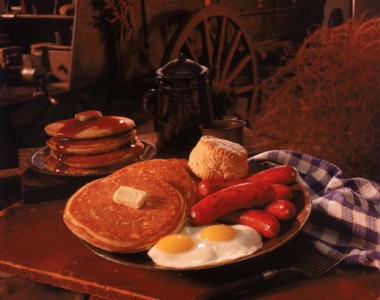There is a great episode from the 1990s TV show Northern Exposure in which everyone in the story’s fictitious town of Cicely, Alaska was trying to eat more in order to pack on the winter weight before the first snowfall.
“Pigs in a blanket, cheddar cheese omelette, homefries, a double order of biscuits and gravy and an extra-thick chocolate shake,” backwoodsman-turned-barkeep Holling Vincoeur lists as he brings an order to retired Wall Street trader-turned-trapper Walt Kupfer.
“What do you think?” Walt asks. “Have I got 8,000 calories here?
“Oh sure, easy,” replies Holling. “How much are you trying to put on this winter?”
“I always like to have an extra 15 pounds on me. What do you have for dessert?”
Ours is a culture obsessed with getting more. More money. More prestige. More stuff. More of everything—except weight. Rarely do we allow ourselves such indulgences. So it’s especially refreshing to take solace in the celebration of wintertime eating: the time-honored tradition of ingesting more in order to stay warm during the coldest months of the year.
As Brendan Leonard, author of The New American Road Trip Mix Tape, notes in his recent Semi-Rad.com blog post, a Google search including the phrases “New Year’s resolution” and “lose weight” will give you over 3 million results. (Now, that’s a lot of obsession.) And the first 10 results of a search for “holiday eating” include the word “health.”
But rather than feeling bad about the natural desire to eat more when it’s cold out, Leonard suggests embracing the body’s need for “some extra furnace fuel” to stay warm.
“Instead of eating fruits and vegetables, try substitutes like pumpkin pie, Cranberry Bliss Bars, fruitcake, or cherry cheesecake,” Leonard quips.
“Skip the skim milk, soy, or almond milk,” he continues. “Ask the barista to make your latte with whole milk, or better yet, half and half.”
Hear, hear. Finally, some cold weather eating advice that makes sense. What’s a wintertime grocery bag without an extra-large block of Cabot’s “Seriously Sharp” cheddar cheese, plastic-wrapped in that comforting red-and-black hunter flannel print? What’s a bowl of steaming hot oatmeal without a spoonful or two of creamy peanut butter? A cup of chili without a sourdough bread bowl? Or a mug of hot chocolate without a hearty helping of fluff, a handful of marshmallows, or a pinch of cinnamon and cayenne pepper?
Answer: Food that is too skimpy to be eaten in sub-freezing temperatures.
“When we ‘burn’ calories, our bodies experience a slight elevation in temperature,” Columbia University Q & A answer-provider “Alice” notes on the college’s Health Services webpage, “[and] when we are feeling cold… our metabolism slows down a bit. That’s why we shiver: our body is attempting to create heat and keep our internal organs warm.”
The need for calories, of course, increases with the amount of energy we are exerting while engaged in various activities, be they heading out across campus to class, belaying an ice-climbing buddy, shoveling snow from the front walk or exploring the polar regions of our planet.
When engaged in such an expedition, arctic adventurer Ann Richards consumes at least 6,000 calories each day. To do this, she “adds a lob of butter” to both her freeze-dried hot cereal breakfast and her add-water-and-stir dinner-in-a-pouch. The butter “takes the calories up,” she tells the BBC, allowing her to add a couple hundred calories to each meal.
After all, as Julia Child famously said, “With enough butter, everything is good.” Even, apparently, freeze-dried meals-in-a-pouch.
Thankfully, here in the Valley we don’t have to resort to such polar pack-in, pack-out practices. Our neighborhood restaurants are filled with dishes that will not only fill you up, but keep you warm as well.
If only wintertime eating lasted year-round.•



